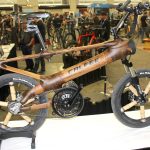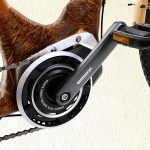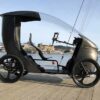Bamboo bikes and e-bikes: what has happened since 1894?
28.09.2021
4311
Since its introduction in 1894, bamboo cycles have been continually changed and have become increasingly sophisticated and appealing. Despite all their advantages and current innovations, many of them have not gained the same universal popularity as their steel, aluminum or carbon frame counterparts.
Some of the first references to the bamboo bicycle may be found in English patent No. 8274, filed in 1894 [1]. The unusual nature of such bicycles stems from the idea that the carrier tubes of the framework are made from grass, something that grows naturally. The bamboo is simply collected and then, with some preparatory operations, used for making the frames of the bicycles. The earliest models used resin-soaked fibers to connect the frame elements, then metal locks (lugs) appeared. More and more in recent years, the connectors are made of an aluminum alloy or carbon filament, including parts made with a 3D printer.
There are environmental advances in using bamboo as a feedstock: it is very fast growing, requires a minimum amount of pesticides and water, as well as being an ample source of oxygen.
What are the benefits of a bamboo framing?
Microstructure is the real secret of bamboo’s extraordinary properties. The fibers of different sizing cascade into successive regular lines in nature. This is the same property that designers are attempting to replicate when engineering carbon fiber. Additionally, bamboo delivers the smoothest riding experience because of its natural anti-vibration properties. Precisely because it has an optimum ratio of sturdiness to weight, the ability to absorb vibrations and sufficient stiffness, bamboo is being used as a material for bike frames. The current bamboo frame, for instance, in the Aero Bamboo Bike created by the Bamboo Bicycle Club team weighs only 1.3 kilograms [2].
With the rise of the environmental movement, bamboo is being increasingly applied to high-end and relatively cheap disposable bicycles alike. But despite all their advantages and prerequisites, these bamboo bicycles have not yet achieved the universal popularity as their steel, aluminum or aluminum carbon frame analogues. Can this be because it is not often that you can find a bamboo model in the store to do a test ride?
Bamboo bike with his own hands
It is possible to construct a bamboo bicycle yourself. The Bamboo Bicycle Club [3], founded by James Marr in London in 2012, has worked to perfect self-assembly techniques (self-build) of bicycles, working on truly exceptional models that are eco-friendly and can be recycled completely after use.
Bamboo frame kits are also available from bicycle producers, such as the company Calfee Design [4]. The specialists of this company constructed their first Bamboo bicycle in 1995, and, since then, have been engaged in improving it. The basic design enables them to make any size and any kind of model. The Calfee DIY Kit drawings blueprints incorporate layout geometry for all sizes of frames for the bike type of your choice.
One cannot ignore that one can find enough informational materials on the Internet, which are devoted to a turn-by-turn description of making a custom bamboo bicycle with their own hands [5].
Modern bamboo bicycle models
When you go online to shop for a specific type of bicycle, there are hundreds, if not hundreds of thousands, of manufacturers and models. But when you specify you want to purchase a bamboo bike, you will be baffled. Generally, we can say that along with hundreds of designs, only a few dozens of manufacturers provide mass-produced bicycles with bamboo frames [6].
However, it is also possible to find a bamboo bicycle manufacturer, for example, in Switzerland [7]. The small company Drehmoment strives forward to offering a very attractive, practical and natural product to a wide variety of customers at a sensible price. Here they build bicycles for people who value aesthetics and are looking for elegant alternatives. For this reason, the Swiss design not just frames rolled from several tubes, but really beautiful and stylish bamboo bikes weighing less than 10 kg.
The American company Greenstar Bikes began to develop bicycles in 2010, and in 2012 their first bamboo bicycle prototype was already undergoing road tests [8]. They are currently producing a number of models using a proprietary process of joining frame elements and locks (lugs) made of 6061 aluminum alloy or carbon filament. The manufacturer states that one of the most popular models, the EcoCross Hybrid, is ideal for the streets, highways and off-road. The frame weighs less than 2.3 kg, and the weight of a fully equipped bike is in the range of 15 kg.
The Chinese company Bamboom [9] works on the place where the raw material of the frame is produced. Translated from English means “Bamboo” and “Boom”, which means the advent of the era of bamboo bicycles. The lineup is small and, includes road, city and electric bikes in different modifications, which can be equipped with both chain and belt drive. In general, we can say that the classic layout of Bamboom bicycles expresses a combination of sports style and the trend to protect the environment. The manufacturer uses carbon fiber locks and high temperature carbonization bamboo for the frames.
The lead engineer of Viet Bamboo Bike, after graduating from the Vietnam Polytechnic University, received a master’s in automatic technology in Berlin, Germany [10]. How fate, after visiting exhibitions and research seminars conducted by his university, including on the subject for bamboo bikes, became increasingly interesting in this subject. Consequently, he organized production in his native country, today, Viet Bamboo Bike presents several dozens of models of both frames and complete bikes for different applications, from urban to MTB Bikes.
When talking about manufacturers, we cannot fail to cite the example of Ghana Bamboo Bike Initiative [11], an Africa-based organization that designs and produces models of bamboo frames and bicycles. The dozens of people involved in the production of frames in Ghana receive “fair pay, social insurance, and, most importantly, prospects for themselves as well as their families in the future.” The development of that project is being supported by the German company my-Woo [12], whose facilities are located in Kiel.
Exotic and designer bicycles
Annually, every year, manufacturers as well as designers introduce to the public a large variety of new designs, the main tendency of which is the filing of new shapes that are feasible to produce from bamboo. Among this group, we should mention the model LUNTIAN 2.0 from the Canadian company Bambike [13]. This bamboo bike is fitted with a nicely curved dual top tube and, as the manufacturer states, is prepared to effectively traverse city jungles, while also well equipped to go off-road.
Smart Energy Bike is a design that blends bamboo and composition with the latest in bicycle technology. Both materials do an outstanding job of their intended purpose. The bamboo ensures durability and vibration damping, while the bamboo carbon ensures the frame’s rigidity. It was designed as part of RedBull’s 2017 “Drahtesel” contest celebrating the 200th anniversary of the bicycle’s invention. Now everyone can now build this eye-catching and ultra-reliable bicycle themselves [14].
HERObike showed off its Bamboost bike with a composite bike frame with added balsa wood and 3D-printed parts [15]. The vacuum-molded sides consist of an inner carbon fiber layer, which is followed by layers of wrapped bamboo, a core of balsa wood, another layers of woven bamboo, and last but not least, a protection layer of resin. The Bamboost model has the additional functionality provided by a leather cargo bag that can be removed from the handlebars when the bike is in use and can be taken along with it.
Electric bamboo bikes
It’ s not difficult to mount an electrical motor on the rear wheels of a traditional bicycle, including bamboo frames, so many manufacturers are making it work. For example, the French startup Cyclik, which specialized in producing bamboo bicycles, recently unveiled an electrical model Relief, which has a 250W rear drive and weighs only 16.5 kg [16].
The unusual-looking electrical prototype with a custom bamboo frame, developed by Calfee Design, is fitted with a spring component in the top part of its frame. The bike is powered by a Bafang 1500-watt medium-sized motor with a 54V battery. He also has a dynamo in the front wheel, which produces the electricity for the 12V lighting system [17]. There is a Sturmey-Archer hub drivetrain in the rear wheel. Operating in combination with the Bafang, it allows speeds up to 65 km/h.
Boomers’ bamboo bicycles and frameworks have been in existence for several years, but the Ghana-based firm only recently unveiled the My Volta mid-motor model [18]. The bicycle venture is also part of the Yonso Project, which channels profits directly back into Ghanaian educational projects. The My Volta incorporates a Shimano Steps E-6000 drive, lights and a Shimano Nexus 8 gear and is allegedly less than 20 kilograms.
Not to mention, there are simpler bamboo designs with front-wheel-drive electrically-powered bicycles as well. The models from BambooBikes weigh about 15.5 kg together with a battery and create workplaces for people in Africa and Asia, from where they are made, designed, designed and sold for people with disabilities or seniors in Israel [19].
There are many advantages, but are there any disadvantages?
In addition to a number of merits, discussed above and about which one can still read a lot here [20], the bamboo as a raw material also has its drawbacks, which somehow need to be taken into consideration in mass production.
Once cut, the bamboo needs to dry. When bamboo loses moisture, it settles much more strongly than any other kind of wood. In addition, one of the major drawbacks of bamboo products is its low tolerance to fungi and bacteria. For this reason, a specific treatment is required, or the material will otherwise be of short lifespan [21].
No doubt that the products from a bamboo in general are eco-friendly, but – it is organic material. There are no 100% organic materials that will remain strong for many more years, particularly when used in various environmental climates. So, to last 10 years – bamboo also needed a special treatment.
Mother nature provides the bamboo tubing in a huge variety of diameters and thicknesses across the wall. Consequently, the matching process for one frame kit can be time consuming, considering that no two parts in the range of the bamboo range are or can be identical [22].
Although various jointing technologies are predominant, determination of the mechanical structural strength of bamboo constructions causes some difficulty in engineering computations on 3D models [23].
In summary
The above-mentioned materials only partly demonstrate the variety of the bamboo bicycle’s construction since its introduction in 1894. One way or another, at least today, the bamboo models are as popular as other types of bikes, both classic and electric. At the same time, structurally, bamboo bicycle is continuously changing and is becoming more and better and more attractive. That is why the purpose of the present publication is to tell us not only about the virtues, but also to highlight, at least in general, the drawbacks of the bamboo source material from the point of view of serial manufacturing.
Detailed information:
[1] What’s stopping the bamboo bike from shooting into the mainstream? – https://www.theguardian.com/environment/2009/jun/22/bamboo-bike
[2] Aero Bamboo Bike looks very unbamboo-like – https://newatlas.com/aero-bamboo-bike/42235/
[3] Bamboo Bicycle Club – https://bamboobicycleclub.org
[4] Calfee Design Bamboo bicycle DIY kits – https://calfeedesign.com/bamboo-diy/
[5] How to Build a Bamboo Bicycle – https://www.instructables.com/How-to-Build-a-Bamboo-Bicycle/
[6] What are the disadvantages of buying a bamboo bike? – https://sustainabilitymattersdaily.com/what-are-the-disadvantages-of-buying-a-bamboo-bike/
[7] Drehmoment Bamboo Bikes – https://www.drehmoment-bikes.ch
[8] Greenstar Bikes – https://www.greenstarbikes.com/prototype
[9] Bamboom Bicycles – http://www.bamboom.com.cn/en/about.html
[10] Viet Bamboo Bike – https://vietbamboobike.com/pages/the-story-of-viet-bamboo-bike
[11] Ghana Bamboo Bike Initiative – http://ghanabamboobikes.org/who-we-are/
[12] my-Вoo – https://www.my-boo.de/ueber-uns/unsere-story
[13] Bambike LUNTIAN 2.0 – https://www.bambikecanada.com/shop/ys0uo02bvgzlfpekqswtszetr82vfr
[14] Smart Energy Bike – http://smartgrassbicycles.com/wordpress/2017/10/30/smart-energy-bike/
[15] Bamboost e-bike combines bamboo and balsa with a touch of tech – https://newatlas.com/bamboost-bamboo-composite-e-bike/36446/
[16] A bamboo electric bike made in France – https://new.in-24.com/sport/motorbike/176174.html
[17] Bamboo e-bike is ready for the streets of Bedrock – https://newatlas.com/calfee-design-bamboo-e-bike/48364/
[18] E-Bike News – https://electricbikereport.com/e-bike-news-amazon-deliveries-bamboo-ebike-tandem-ebike-austin-fleet-more/
[19] BambooBikes – https://www.bamboobike.co.il/about/?lang=en
[20] Why Bamboo? – https://www.greenstarbikes.com/why-bamboo
[21] DISADVANTAGE OF BAMBOO AS A CONSTRUCTION MATERIAL – https://jasondreamwork.wordpress.com/2016/05/21/disadvantage-of-bamboo/
[22] Melbourne-based ‘bike nut’ Michael Efford gets serious about bamboo – https://www.habitusliving.com/products/accessories/bamboo-bikes
[23] Bamboo as a Building Material – https://theconstructor.org/building/bamboo-as-a-building-material-uses-advantages/14838/

















